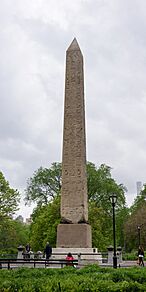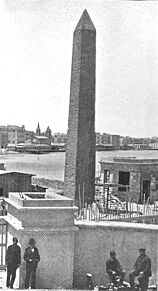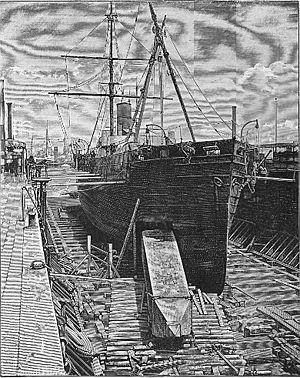Cleopatra's Needle (New York City) facts for kids
Cleopatra's Needle in New York City is a tall, ancient stone pillar. It is one of two similar pillars, both called Cleopatra's Needles. These monuments were moved from the ruins of a temple in Alexandria, Egypt, in the 1800s.
This particular stone monument, which is over 3,000 years old, was placed in Central Park on February 22, 1881. It stands west of the Metropolitan Museum of Art's main building in Manhattan. An American official in Egypt, Judge Elbert E. Farman, helped get the obelisk as a gift from the Egyptian ruler, known as the Khedive. This gift was a thank you to the United States for staying neutral when other European countries were trying to control the Egyptian government. A rich railroad owner named William Henry Vanderbilt paid most of the costs to transport the obelisk.
Contents
History of the Obelisk
From Ancient Egypt to Rome
This obelisk is made of red granite. It stands about 21 meters (69 feet) tall and weighs around 200 tons. Its sides are covered with Egyptian hieroglyphs, which are ancient Egyptian writings.
The obelisk was first put up in the ancient Egyptian city of Heliopolis in 1475 BC. This was ordered by Thutmose III. The granite for the obelisk came from quarries near the Nile River. About 200 years later, Ramesses II added more inscriptions to celebrate his army's victories.
Later, around 13 BC, the Romans moved the obelisks to Alexandria. They placed them in a temple called the Caesareum, which was built by Cleopatra.
How America Got the Obelisk
The idea of bringing an Egyptian obelisk to New York City started in March 1877. Newspapers reported on the transport of a similar obelisk to London. They mistakenly said that the ruler of Egypt, Isma'il Pasha, had offered an obelisk to the U.S. as a gift for increased trade.
In March 1877, Henry G. Stebbins, who worked for New York City's park department, began trying to raise money to move the obelisk. However, when William H. Vanderbilt was asked to help, he offered to pay for the entire project himself. He donated more than $100,000, which was a huge amount of money in 1877.
Stebbins then sent letters to the Khedive through the U.S. government. These letters were sent to Judge Farman in Cairo. Judge Farman realized he might be able to get one of the two remaining standing obelisks. He formally asked the Khedive in March 1877 and secured the gift in writing by May 1877.
The Big Journey to New York
Moving the 200-ton granite obelisk from Alexandria to New York was a very difficult job. It was led by Henry Honychurch Gorringe, a U.S. Navy officer. First, the obelisk had to be carefully laid down from its upright position. This was a risky process, and it almost crashed to the ground.
In August 1879, the moving process stopped for two months because of protests from local people and legal issues. Once these were solved, the obelisk was moved seven miles to Alexandria. Then, it was loaded into the cargo hold of a steamship called the SS Dessoug. The ship had to be changed a lot, with a large hole cut into its side. The obelisk was rolled into the ship through this hole using cannonballs. The ship set sail on June 12, 1880.
Even with a broken propeller, the SS Dessoug made it to the United States. The obelisk and its heavy 50-ton base arrived in New York in early July 1880. It took 32 horses, hitched in pairs, to pull it from the banks of the East River to Central Park. Railroad tracks had to be temporarily removed, and the ground flattened to move the obelisk. It was carried up the East River and then to a temporary spot near Fifth Avenue.
The final part of the journey involved pushing the obelisk with a steam engine across a special bridge built from Fifth Avenue to its new home. This spot was called Greywacke Knoll, right across from the Metropolitan Museum of Art. It took 112 days to move the obelisk from the Quarantine Station to its final resting place.
On October 2, 1880, a special ceremony was held by the Masons to lay the cornerstone for the obelisk. Over 9,000 Masons marched up Fifth Avenue, and more than 50,000 people watched. The obelisk was then stood upright using a special machine built by Henry Honychurch Gorringe. The official ceremony for putting up the obelisk was on January 22, 1881.
Choosing the Location
The obelisk was placed in a somewhat hidden spot behind the museum. Henry Honeychurch Gorringe, who managed the move, along with William Henry Hurlbert and Frederic Edwin Church, chose the site in 1879. Gorringe wrote that they kept the location a secret to avoid arguments. He noted that the best thing about the chosen spot was that it was "isolated" and high up. This meant the obelisk's foundation could be strongly attached to the solid rock below, protecting it from any big natural disasters.
Ancient Egyptian Hieroglyphs
The surface of the stone is very worn down by the weather, which almost hides the rows of ancient Egyptian writings on all sides. Pictures taken when the obelisk was first put in the park show that these hieroglyphs were still easy to read. They were carved first by Thutmosis III (1479–1425 BC) and then, about 300 years later, by Ramesses II the Great (1279–1213 BC).
The stone had stood in the dry Egyptian desert air for almost 3,000 years and had not worn down much. But in just over a century in New York City's climate, city pollution and acid rain have damaged its surface. In 2010, Dr. Zahi Hawass, a famous Egyptian archaeologist, wrote a letter asking New York City to do more to protect the obelisk. He even suggested that if they couldn't care for it properly, Egypt might try to bring this valuable ancient object back home.
Hidden Treasures
A time capsule was buried beneath the obelisk. It contains items like an 1870 U.S. census report, a Bible, a Webster's Dictionary, the complete works of William Shakespeare, a guide to Egypt, and a copy of the United States Declaration of Independence. A small box was also placed in the capsule by the man who arranged the obelisk's purchase and transport, but what's inside it remains a mystery.
See also
 In Spanish: Aguja de Cleopatra (Nueva York) para niños
In Spanish: Aguja de Cleopatra (Nueva York) para niños
- List of Egyptian obelisks





